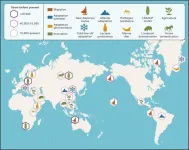(Press-News.org)
U.S. flu vaccines are likely to move from quadrivalent to trivalent due to a change in circulating influenza viruses, says a University of Michigan researcher.
Currently, all influenza vaccines in the United States are quadrivalent, meaning that they protect against four different flu viruses.
In a new paper published in the New England Journal of Medicine, researchers detail the spread of influenza B/Yamagata virus, which has not been in circulation since early 2020; the regulatory discussions and recommendations on updating vaccines; and the manufacturing considerations for new vaccine formulations for the U.S. and abroad.
"The removal of B/Yamagata virus is logical as we do not want to include a virus in vaccine formulation that is no longer in circulation," said Arnold Monto, professor emeritus of epidemiology and global public health at the U-M School of Public Health.
"It also gives us the space to replace B/Yamagata virus with a component that will give improved protection against the circulating influenza viruses. That will take additional studies to accomplish."
Monto has dedicated his career to researching the occurrence, prevention and control of respiratory infections. He also serves as a member of the U.S. Food and Drug Administration's Vaccines and Related Biological Products Advisory Committee.
Co-authors include Maria Zambon of the U.K. Health Security Agency and Jerry Weir of the Division of Viral Products, Center for Biologics Evaluation and Research at the U.S. Food and Drug Administration.
Paper: The End of B/Yamagata Influenza Transmission—Transitioning from Quadrivalent Vaccines
Written by Destiny Cook, U-M School of Public Health
END
Changes in flu circulation means US likely to see vaccines move from quadrivalent to trivalent
2024-02-29
ELSE PRESS RELEASES FROM THIS DATE:
Accreditation with commendation awarded to the American College of Chest Physicians
2024-02-29
Glenview, IL– The American College of Chest Physicians® (CHEST) has received accreditation with commendation from the Accreditation Council for Continuing Medical Education (ACCME) and reaccreditation from the Society for Simulation in Healthcare (SSH).
This achievement grants CHEST reaccreditation through November 2029 and places the organization in the highest tier of all continuing medical education (CME) providers, including some of the nation’s most prestigious medical schools and professional medical societies.
“Receiving reaccreditation with commendation from the ACCME is a real testament to the education team at CHEST including both internal ...
Hahn awarded CZI grant to monitor, manipulate proteins important in nervous system function, neurological disease
2024-02-29
CHAPEL HILL, N.C. – The Chan Zuckerberg Initiative (CZI) announced four multi-year Exploratory Cell Networks grants for researchers exploring the frontiers of genomics, cell biology, and synthetic biology by developing new measurement technologies. The projects will be bringing together regional labs in California, the Mid-Atlantic, and the Research Triangle.
Klaus Hahn, PhD, the Ronald G. Thurman Distinguished Professor of Pharmacology and member of the UNC Lineberger Comprehensive Cancer Center, will be co-leading a ...
All-light communication network bridges space, air and sea for seamless connectivity
2024-02-29
WASHINGTON — Researchers have developed an all-light communication network that enables seamless connectivity across space, air and underwater environments. The new network design combines different types of light sources to ensure connectivity no matter the environment.
“In today’s world, data transmission is critical for communication, navigation, emergency response, research and commercial activities,” said research team leader Yongjin Wang from Nanjing University of Posts and Telecommunications and ...
Parents, wealth, race drive girls’ chances to play sports
2024-02-29
COLUMBUS, Ohio – The likelihood that a girl will participate in high school sports in the United States is driven not so much by individual choice, new research suggests. Instead, decisions made by parents, the wealth of one’s family and community, and racial dynamics matter.
By combining interviews with elite college athletes and analysis of data on over 4,000 high school girls, researchers found that socioeconomic status – of families and the school districts in which they live ...
Study sheds light on how neurotransmitter receptors transport calcium, a process linked with origins of neurological disease
2024-02-29
A new study from a team of McGill University and Vanderbilt University researchers is shedding light on our understanding of the molecular origins of some forms of autism and intellectual disability.
For the first time, researchers were able to successfully capture atomic resolution images of the fast-moving ionotropic glutamate receptor (iGluR) as it transports calcium. iGluRs and their ability to transport calcium are vitally important for many brain functions such as vision or other information coming from sensory organs. Calcium also brings about changes in the signalling capacity of iGluRs ...
Artificial intelligence reveals prostate cancer is not just one disease
2024-02-29
Artificial Intelligence has helped scientists reveal a new form of aggressive prostate cancer which could revolutionise how the disease is diagnosed and treated in the future.
A Cancer Research UK-funded study published today, 29 February 2024, reveals that prostate cancer, which affects one in eight men in their lifetime, includes two different subtypes termed evotypes.
The discovery was made by an international team led by the University of Oxford, and the University of Manchester, who applied AI (artificial intelligence) on data from DNA to identify two different subtypes affecting the prostate.
The team hope their findings could save thousands ...
New type of stem cells contains potential for knee cartilage regeneration in arthritic mice
2024-02-29
Osteoarthritis (OA) is a debilitating joint disease which affects over 500 million people worldwide, with trends increasing as populations age. OA is caused by progressive, irreversible degeneration of joint cartilage, leading to pain, swelling and immobility in the affected joint. Current therapies focus on symptom relief but cannot restore degenerated cartilage.
A potentially alternative treatment is the regeneration of cartilage from stem cells. Importantly, not all types of stem cells can make cartilage and earlier clinical trials with mesenchymal stem or stromal cells (MSCs) obtained did not convincingly show that MSCs make new cartilage when given to OA patients. In search for the ...
Becoming human: An ancient genome perspective
2024-02-29
Writing a commentary in the 50th anniversary issue of Cell, FU Qiaomei and E. Andrew Bennett, both of the Institute of Vertebrate Paleontology and Paleoanthropology (IVPP) of the Chinese Academy of Sciences, explored the contribution of paleogenomics to our understanding of the evolution of modern humans.
Given her numerous contributions to the field of human evolution through the analysis of both archaic and early modern human genomes, Prof. FU was invited by the journal Cell to write a commentary reviewing what we have learned about the evolution ...
Extreme weather events tied to increased mortality and emergency department activity
2024-02-29
Climate change is increasing the frequency and intensity of severe weather events, which may particularly endanger vulnerable populations such as the elderly. Researchers from Mass General Brigham and colleagues examined how weather disasters between 2011 and 2016 influenced healthcare delivery and mortality among Medicare beneficiaries in affected counties, finding that one week after major weather events, emergency department (ED) use and mortality remained elevated by 1.22% and 1.4%, respectively, from pre-disaster ...
Bottlenecks and beehives: how an invasive bee colony defied genetic expectations
2024-02-29
For more than a decade, invasive Asian honeybees have defied evolutionary expectations and established a thriving population in North Queensland, much to the annoyance of the honey industry and biosecurity officials.
Research published today in Current Biology has shown the species, Apis cerana, has overcome what is known as a genetic bottleneck to grow from a single swarm into a population of more than 10,000 colonies over a 10,000 square kilometre area – which is about the size of Greater Sydney.
Co-lead author Dr Rosalyn Gloag from the University of Sydney School of Life and Environmental Sciences said: “Our study of this bee population shows that some species can ...




